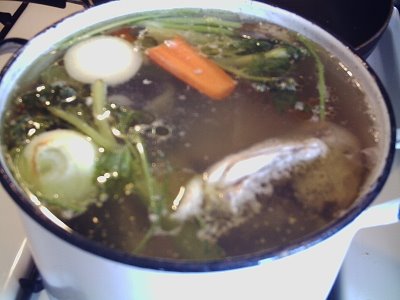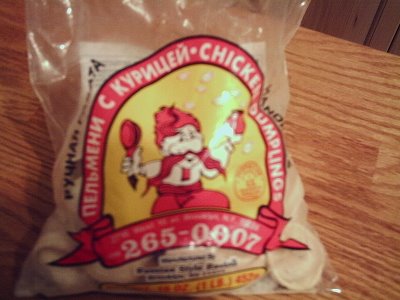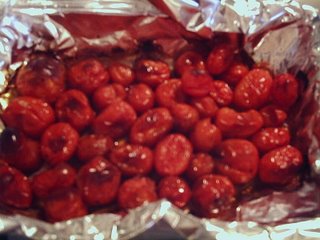 This cheap, fast and easy soup would make a good entry for the poverty line challenge (more on that later). Salmon soup is either my grandmother's or my mom's invention, but I'm claiming the rights. You don't need stock or fresh salmon to make this soup. You do need a can of pink salmon ($2 at the local supermarket; I checked) and the cheap vegetables everyone should have on hand--carrots, potatoes, onions, celery and frozen peas. The salmon makes its own stock as it cooks.
This cheap, fast and easy soup would make a good entry for the poverty line challenge (more on that later). Salmon soup is either my grandmother's or my mom's invention, but I'm claiming the rights. You don't need stock or fresh salmon to make this soup. You do need a can of pink salmon ($2 at the local supermarket; I checked) and the cheap vegetables everyone should have on hand--carrots, potatoes, onions, celery and frozen peas. The salmon makes its own stock as it cooks.Bring 6 cups of water to a boil in a soup pot. While waiting for the water to boil, peel and cube 3 small potatoes. Finely chop a large onion, 2 stalks of celery and 2 carrots. When the water comes to a boil, add the potatoes and some salt; turn heat down to a simmer.
While the potatoes are cooking, heat some olive or vegetable oil in a skillet and saute the onion, celery and carrots until the onions are golden. When the vegetables are nearly done, add a finely minced garlic clove and a handful of chopped parsley; saute for 30-60 seconds. Once the potatoes are almost cooked, add the vegetables, two bay leaves and a couple of sprigs of parsley to the soup pot. Simmer.
 Open a 14 oz. can of pink salmon, break into chunks and carefully remove as much skin and bones from the fish as you can. Add the salmon and the water it was packed in to the soup pot ; simmer 20-30 minutes or so. Add some frozen peas; no need to defrost them. Add salt and pepper to taste. A splash of lemon juice at the very end doesn't hurt.
Open a 14 oz. can of pink salmon, break into chunks and carefully remove as much skin and bones from the fish as you can. Add the salmon and the water it was packed in to the soup pot ; simmer 20-30 minutes or so. Add some frozen peas; no need to defrost them. Add salt and pepper to taste. A splash of lemon juice at the very end doesn't hurt.P., the boyfriend, said this soup reminded him of ukha, the authentic Russian salmon soup. But P. is a shameless flatterer, so take this soup for what it is: Good, fast and about $4 for the whole pot.

























